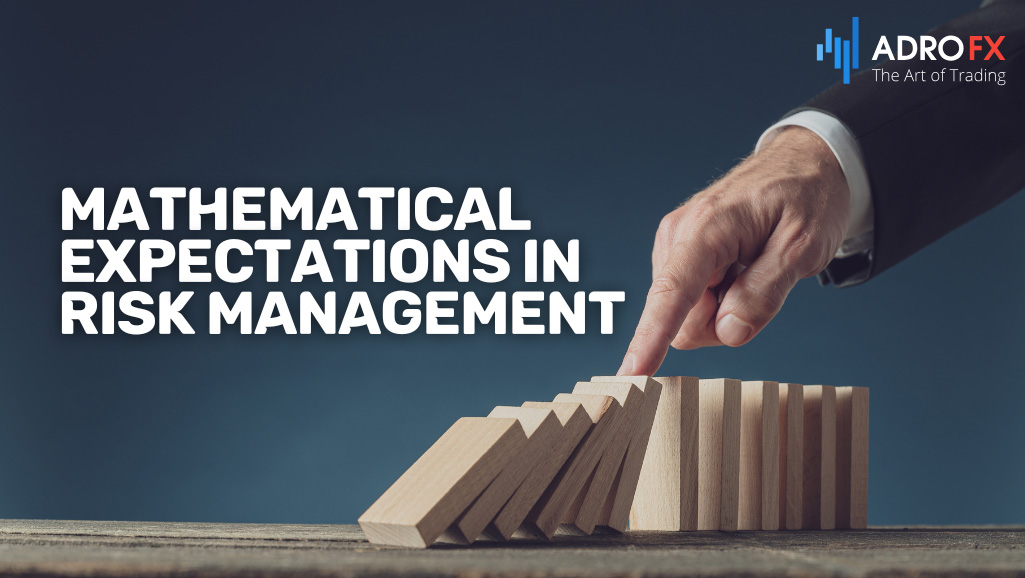The Role of Mathematical Expectations in Trading: How to Use Expected Value for Profitability

In trading, every decision you make has a potential outcome that can either contribute to your profit or loss. While many traders focus on technical indicators or market sentiment, understanding the mathematical expectations behind your trades is a key factor in building a successful strategy.
Mathematical expectations in trading provide a calculated approach to predict the average result of your trades over time. Rather than relying on emotions or market speculation, this concept helps traders assess potential outcomes based on probability and consistency. By incorporating mathematical expectations into your trading strategies, you can make more informed decisions, improve risk management, and enhance long-term profitability.
What is Mathematical Expectation?
Mathematical expectation, also known as expected value, is a fundamental concept in trading that helps you evaluate the long-term potential of your trading strategies. It represents the average result you can expect from a series of trades over time. Unlike focusing on individual trade outcomes, which may vary, mathematical expectation allows you to step back and assess the bigger picture. It helps you estimate whether your strategy is likely to be profitable in the long run.
In essence, mathematical expectation considers both the probability of winning and losing, along with the potential gains or losses associated with each trade. This gives traders a clearer understanding of whether their strategy has a positive or negative expectancy, enabling them to make better-informed decisions and refine their approach to trading. By embracing this concept, traders can better manage risk and increase their chances of achieving consistent profitability over time.
By using mathematical expectations, traders can shift from emotional decision-making to probability-based analysis, leading to more consistent and predictable outcomes. It allows them to see the bigger picture of their trades, ensuring that even with occasional losses, their overall strategy remains profitable.

The Importance of Mathematical Expectations in Risk Management
In trading, managing risk is just as crucial as making profits, if not more so. Mathematical expectations play a significant role in helping traders assess risk and reward, enabling them to make informed decisions that safeguard their capital while pursuing profits. By understanding the expected value of their trades, traders can determine whether the potential reward justifies the risk, and develop strategies to mitigate potential losses.
One of the core principles in risk management is the risk-reward ratio - this compares the potential gain of a trade to the possible loss. A good trading strategy will typically have a risk-reward ratio of at least 2:1, meaning the potential reward is twice as high as the potential loss. Mathematical expectation helps traders calculate this ratio more effectively by considering both the probability of winning and losing, as well as the size of those wins and losses.
Assessing Risk and Reward with Mathematical Expectation
Mathematical expectations provide a more nuanced way to evaluate risk by factoring in both probability and outcome. Instead of just focusing on a high win rate or a large payout, traders use mathematical expectation to gauge whether the long-term benefits of their strategy outweigh the associated risks.
For example, a trader might win only 40% of the time but have a much larger reward on each win than their losses. If the average win is $300 and the average loss is $100, the trader can still have a positive mathematical expectation, meaning the strategy will be profitable over time, despite a lower win rate.
This ability to assess trading risk through mathematical expectations is essential for maintaining a disciplined approach. By understanding that a single trade doesn’t define their success, traders are less likely to react emotionally to short-term losses. They can focus on long-term results, knowing that as long as their strategy has a positive mathematical expectation, it will generate profits over time.
Loss Management and Discipline
Mathematical expectations also help traders manage their losses by encouraging a methodical approach. When traders know the expected value of their trades, they’re less likely to chase losses or overreact to individual trade outcomes. This is particularly important in managing emotions like fear and greed, which can cloud judgment and lead to impulsive decision-making.
For instance, when a trader experiences several consecutive losses, it can be tempting to deviate from their plan in an effort to recoup those losses quickly. However, a trader who understands their strategy’s positive mathematical expectation will recognize that those losses are part of the broader trading cycle. This knowledge fosters discipline, allowing traders to stick with their strategy, rather than making irrational decisions in an attempt to recover from short-term setbacks.
In summary, mathematical expectation is a critical tool in risk management because it provides traders with a realistic perspective on their trading performance. By focusing on the long-term average outcome rather than short-term wins or losses, traders can better manage risks, avoid emotional decision-making, and build a consistent, disciplined approach to trading.
Also read: Tailored Investments: Leveraging Your Risk Tolerance for Optimal Return

How to Calculate Mathematical Expectation in Trading
Calculating mathematical expectation in trading is a straightforward process, but one that requires careful attention to detail. This calculation helps traders understand the long-term profitability of their trading strategy by evaluating the average outcome of a trade over time. Here’s a step-by-step guide to calculating mathematical expectation, along with examples to illustrate how it works in common trading scenarios.
Step-by-Step Guide to Calculating Mathematical Expectation
To calculate mathematical expectation, you need two key pieces of information:
- The probability of winning and losing a trade.
- The average gain or loss from winning or losing trades.
The formula for calculating mathematical expectation (E) is:
E=(Pwin×W)+(Ploss×L)E=(Pwin ×W)+(Ploss ×L)
Where:
- Pwin = the probability of winning (expressed as a decimal, e.g., 0.60 for 60%)
- W = the average profit from a winning trade
- Ploss = the probability of losing (e.g., 0.40 for 40%)
- L = the average loss from a losing trade
Example 1: A Simple Trading Scenario
Let’s consider a trader who has a strategy that wins 70% of the time and loses 30%. The average win is $150, and the average loss is $100. Plugging these values into the formula:
E=(0.70×150)+(0.30×−100)E=(0.70×150)+(0.30×−100)E=105−30=75E=105−30=75
In this scenario, the mathematical expectation is $75 per trade. This means that, on average, the trader can expect to earn $75 for each trade over the long run, despite occasional losses.
Example 2: Adjusting for a Lower Win Rate
Now let’s look at a strategy with a lower win rate. The trader wins 40% of the time, but their wins are much larger, averaging $300 per trade, while their losses average $100. The formula becomes:
E=(0.40×300)+(0.60×−100)E=(0.40×300)+(0.60×−100)E=120−60=60E=120−60=60
Despite winning less frequently, the mathematical expectation is still positive at $60 per trade. This highlights the importance of considering both win rate and reward size when assessing a strategy’s long-term profitability.
Importance of Backtesting and Forward Testing
Calculating mathematical expectation based on historical data is an essential step in backtesting a strategy. By analyzing past trades, traders can ensure that their strategy has a positive expectation before applying it in real-time markets. Forward testing, which involves live trading with smaller amounts, can help confirm that the strategy works under current market conditions.
Adjusting Based on Trading Conditions
Traders should continuously recalibrate their calculations based on changing market conditions, as factors like volatility, transaction costs, and slippage can impact the expected value. Additionally, strategies that work well in one type of market (e.g., a bull market) might not perform as expected in another (e.g., a bear market).
By regularly reviewing and adjusting their mathematical expectation, traders can ensure that their strategies remain viable and aligned with their long-term goals.
Mathematical Expectation vs. Emotional Trading: A Comparison
In the world of trading, emotions can often cloud judgment, leading to impulsive decisions that negatively impact results. Emotional trading, characterized by fear, greed, and impulsive actions, tends to overlook long-term strategies in favor of short-term reactions. In contrast, relying on mathematical expectations shifts the focus from immediate gains or losses to a more calculated, probability-based approach.

Emotional Trading: Reacting to Short-Term Outcomes
Emotional traders often react to market fluctuations without considering the broader picture. For example, a string of losses might trigger fear, causing traders to exit positions prematurely or chase losses in an attempt to recover quickly. On the other hand, a series of wins can lead to overconfidence, prompting traders to take larger, riskier positions without proper analysis. In both cases, decisions are driven by emotions rather than data or strategic planning, often resulting in inconsistent or negative outcomes.
The Power of Probability-Based Thinking
Mathematical expectations encourage traders to think in terms of probability and long-term outcomes. By focusing on the expected value of a strategy, traders can make decisions based on the likelihood of winning and losing over time, rather than individual trade results. This shift in thinking fosters discipline, as traders become less reactive to short-term market movements and more focused on executing a consistent plan.
For instance, a trader with a positive mathematical expectation understands that even with a lower win rate, their overall performance will be profitable in the long run if they manage risk appropriately. This probability-based approach helps remove the emotional element from trading, making it easier to stick to a plan, even when short-term results are discouraging.
In short, trading psychology is critical to success, and using mathematical expectations can help traders avoid the pitfalls of emotional trading. By focusing on the bigger picture and relying on probability, traders can make more rational, well-informed decisions that lead to better outcomes over time.
Also read: CFD Trading Psychology: Mastering Emotions for Better Results
Common Mistakes When Using Mathematical Expectation in Trading
While mathematical expectation is a powerful tool for improving trading outcomes, it’s not foolproof. Traders can make several mistakes when using this concept, which can lead to inaccurate calculations or misinformed strategies. Below are some common pitfalls and tips for avoiding them.
Overestimating Probabilities
One of the most frequent errors traders make is overestimating probabilities - believing that a strategy will win more often than it actually does. This happens when traders focus only on recent successes or cherry-pick data to suit their expectations. In reality, markets are unpredictable, and even the best strategies can have periods of underperformance. Overestimating the probability of winning skews the mathematical expectation, giving traders a false sense of security about their strategy’s effectiveness.
To avoid this, traders should use a large sample size of historical data to calculate probabilities, and ensure that their expectations are grounded in realistic, long-term results rather than short-term trends.
Ignoring Market Volatility
Another mistake is failing to account for market volatility. Volatile markets can drastically alter the outcomes of trades, impacting both the probability of winning and the size of potential losses. If volatility is ignored, traders may underestimate the risk and overestimate the potential reward, leading to a flawed calculation of mathematical expectation.
To mitigate this, traders should adjust their expectations based on current market conditions. They can also consider using volatility-based strategies, such as setting wider Stop Loss levels during turbulent times or adjusting position sizes to manage risk more effectively.
Not Including Transaction Costs
Traders sometimes forget to include transaction costs - such as commissions, spreads, or slippage - in their calculations. These seemingly small costs can significantly impact profitability, especially for high-frequency traders. Without factoring in these costs, the mathematical expectation may appear more favorable than it actually is.
Tips for Accurate Calculation
- Use realistic probabilities
Base your win/loss probabilities on a large set of data over different market conditions. - Factor in volatility
Adjust your calculations based on the level of market volatility, as it can affect both the probability of winning and the size of potential gains or losses. - Include all costs
Always account for transaction fees and other trading costs to get an accurate picture of your expected profitability.
By avoiding these common mistakes and applying mathematical expectations accurately, traders can enhance their decision-making process and develop more reliable trading strategies that stand the test of time.
Also read: Future-Proof Forex Trading: Best Strategies for 2024 - 2025

How Mathematical Expectations Can Improve Your Trading Strategy
Incorporating mathematical expectations into your trading strategy can significantly enhance your ability to make well-informed decisions. By understanding the potential outcomes of your trades, you can approach each decision with a clearer sense of risk versus reward, ultimately leading to more consistent results over time.
Using Expectations to Improve Decision-Making
Mathematical expectations allow traders to calculate the expected value of a trade by weighing both the probability of success and the potential reward against the risk of loss. For example, even if you have a lower win rate, a strategy with a high risk-reward ratio could still deliver positive returns over time. This approach helps traders avoid emotional, impulsive trades by focusing on data-driven outcomes.
Integrating Expectations with Technical and Fundamental Analysis
While mathematical expectations provide valuable insight, they work best when combined with other tools like technical and fundamental analysis. Technical indicators can help identify patterns or trends, which can improve the accuracy of your probability estimates. Meanwhile, fundamental analysis gives you a deeper understanding of the assets you’re trading, enhancing your ability to evaluate whether a trade has a favorable expected value.
Here are a few tips for integrating mathematical expectations into your strategy:
- Combine with technical signals
Use moving averages, support and resistance levels, and other technical indicators to improve the precision of your win/loss estimates. - Use fundamental data
Stay updated on economic indicators, earnings reports, or geopolitical events that can affect market conditions, helping you refine your expectations. - Adjust based on volatility
High volatility may require adjusting your position sizes or Stop Loss levels to better align with your calculated expectations.
By applying mathematical expectations alongside traditional analysis methods, traders can create a more robust, data-driven strategy that minimizes guesswork and maximizes long-term profitability.
Conclusion
Understanding and utilizing mathematical expectations can be a game-changer for traders aiming for long-term success. By focusing on probability-based outcomes rather than emotional or impulsive decisions, traders can approach the market with a disciplined and structured mindset. This method allows for more consistent results and helps traders remain confident in their strategies, even when short-term losses occur.
The primary benefit of using mathematical expectations is that it encourages a disciplined approach to risk management, helping traders maintain a clear perspective on both potential gains and losses. Whether you’re trading forex, stocks, or commodities, this concept ensures that you’re making data-driven decisions that align with your overall strategy and goals.
By incorporating mathematical expectations into your trading routine, you’ll improve your ability to manage risk, enhance decision-making, and see more consistent results over time.
Ready to take your trading to the next level? Explore more advanced trading concepts or sign up for a demo account with AdroFx today. Practice using mathematical expectations and refine your strategy in real-time, without the risk. Start building your path toward consistent trading success by mastering this essential concept.
About AdroFx
Established in 2018, AdroFx is known for its high technology and its ability to deliver high-quality brokerage services in more than 200 countries around the world. AdroFx makes every effort to keep its customers satisfied and to meet all the trading needs of any trader. With the five types of trading accounts, we have all it takes to fit any traders` needs and styles. The company provides access to 115+ trading instruments, including currencies, metals, stocks, and cryptocurrencies, which make it possible to make the most out of trading on the financial markets. Considering all the above, AdroFx is the perfect variant for anyone who doesn't settle for less than the best.










